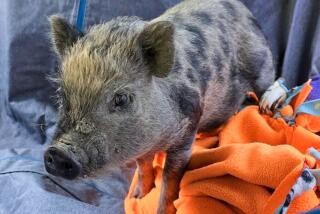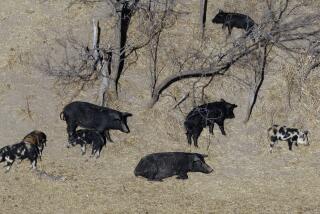ENVIRONMENT : Rooting Out Wild Pigs’ Mischief in Great Smoky Mountains : Efforts to combat the boars and prevent destruction of the area’s biological diversity may be abandoned because of Park Service budget cuts.
- Share via
GREGORY BALD, Tenn. — Nobody knows how this wide, grassy, mountaintop meadow in the Great Smoky Mountains came to be, but if it is not one of nature’s wonders, it is assuredly one of man’s.
Popular speculation is that the Cherokees created it by regularly burning the hundred or so acres for decades, possibly centuries. But whether the open expanse was caused by man or by a quirk of nature, elk and bison evidently grazed it until woody plants finally quit trying to grow, leaving the summit to grass, wildflowers and berries.
Open mountaintops like Gregory Bald, first described in detail in 1824, are scattered through the southern highlands. But now, they are inexorably closing. Saplings are springing up, bushes are reappearing, and trees are creeping in on the edges. The slow shrinking of the open grasslands is, like their origin, something of a mystery.
One culprit, however, is known: Wild pigs, who, like the first white men to come here, made their way to these old mountains from Europe.
The carnivorous rooters come up here in the spring, overturning the sod in search of worms and grubs and digging for bulbs with curved tusks sharpened on tree trunks. Their destruction creates small seedbeds to sprout saplings and woody plants that haven’t grown here for many decades, if, indeed, they ever did.
The invaders’ ecological mischief is not limited to the grassy balds.
Across a region treasured for its rare plants, they move under cover of darkness, eating nearly anything smaller than they--not only roots, bulbs, and flowers, but frogs, snakes, rodents, ground-dwelling birds, and eggs.
In cold mountain springs, they push aside rocks and devour succulent salamanders, and there is some speculation that their digging is even a threat to remaining stands of beech trees.
Seldom has a foreign species persisted more fiercely in a new environment.
In an era of growing concern for the plight of endangered animals, the proliferation of the European pig illustrates a quite different phenomenon. They show what can happen when a species--plant or animal--is released where it does not belong. For example:
* The zebra mussel, believed to have been released into the Great Lakes in ballast water loaded in Eastern Europe, has spread into the Illinois, Mississippi, Ohio, and Tennessee rivers and tributaries. The bean-sized mollusks clog water intake pipes, infest beaches and consume the food sources of valuable fish.
* A foreign, grass-feeding carp being studied in laboratories in Arkansas has escaped into the Mississippi River, and wildlife biologists fear it will wipe out grasses where the eggs of indigenous species hatch.
* Wild goats and pigs have plagued barrier islands off California.
* In the Eastern United States, the gypsy moth chews its way south year by year, stripping hardwood forests and spreading through shady suburbs in spite of chemical assaults. Now, an Asian variety of the moth has arrived in the Pacific Northwest.
* Recently, the U.S. Department of Agriculture issued an all-points bulletin for fist-sized African snails illegally imported in recent years as terrarium pets. Officials are concerned because a similar snail escaped custody in Miami in the 1970s. The government spent $7 million to eradicate it before it went on a rampage in search of fruits and vegetables.
The list of exotics is exhaustive, but some of the prominent longtime entries are hardly thought of as invaders anymore. The English sparrow is ubiquitous. The kudzu vine could be considered the national plant of Dixie.
In Olympic National Park alone, biologists count 169 exotic, or non-indigenous, species.
Some were introduced accidentally, some intentionally--as was the case with the European pig, which has crossbred with feral hogs and been spread across the land, becoming the valued prey of hunters in some places and the bane of environmentalists and government agencies in areas such as the Great Smoky Mountains National Park.
In the Smokies, wrote Michael Frome in “Strangers in High Places,” his classic story of the nation’s most visited national park, “The boar is loaded with power in his hoofs as well as the tushes. The hoofs are narrower than a domestic pig’s and more sharply edged; the legs are longer, stronger, and more supple. Thus the boar can stomp on a rattlesnake, and cut him to ribbons for his dinner. He can run or jump up steep banks, cross streams over narrow logs, while the domestic hog must wade through the stream. He can leap over obstacles like rocks or downed logs.”
The generally accepted account of the pigs in the southern highlands is that they were brought to western North Carolina by one George Gordon Moore, a wealthy sportsman who established a 600-acre hunting preserve. According to Frome, it was stocked not only with 15 pigs that Moore had bought from a German who represented them as a species native to the Ural Mountains of Russia, but bison, elk, Colorado mule deer, Russian brown bear, ring-necked pheasant, sheep and wild turkey.
(Moore also transplanted the pigs to his estate near Carmel. During the winter, Moore and his friends from New York hunted the critters on horseback with 12-foot spears.)
Moore eventually gave up on the North Carolina preserve, and his stock faded into the wilderness, all except the pigs, whose progeny eventually moved into Tennessee and apparently swam the Little Tennessee River sometime in the ‘40s or ‘50s. They thus reached the southernmost area of the Great Smoky Mountains National Park, one of North America’s treasures of biological diversity.
Facing few predators, they spread steadily through the park’s 520,000 acres.
By the mid-’70s, Susan Bratton of Cornell University, Michael Pelton of the University of Tennessee, and other scientists were becoming concerned over the rooters’ growing damage in the park.
The National Park Service put out traps, caught a few, and hauled them away to be hunted in game preserves, but the infestation worsened. By 1986, the Feds in the Smokies had had enough.
Officials sought them with baited box traps and rifles. With spring, when the pigs began moving to higher elevations, they were pursued by sharpshooters equipped with night-vision devices.
By the end of the first season, 1,146 had been trapped and hauled away or killed by the marksmen. The numbers have since declined, dropping as low as 366 in 1988.
But having spent $175,000 to $225,000 per year in the battle, the National Park Service now faces the prospect of abandoning its efforts. The budget for the coming year includes no money for a natural resources protection fund, which has been used for special projects, including pig eradication.
Without enough money, experts fear a population explosion that could put the park back where it was a decade ago--with the ugly, foul-smelling animals again rooting up the lawn at visitors centers, appearing on hiking trails, and overturning the sod on the open mountaintops such as Gregory Bald.
Troubled Habitat
Mountaintop grasslands such as Gregory Bald in the Great Smoky Mountains are beginning to fill in with trees and shrubs. Among the culprits are the European wild pig, which overburdens the habitat.
More to Read
Sign up for Essential California
The most important California stories and recommendations in your inbox every morning.
You may occasionally receive promotional content from the Los Angeles Times.












